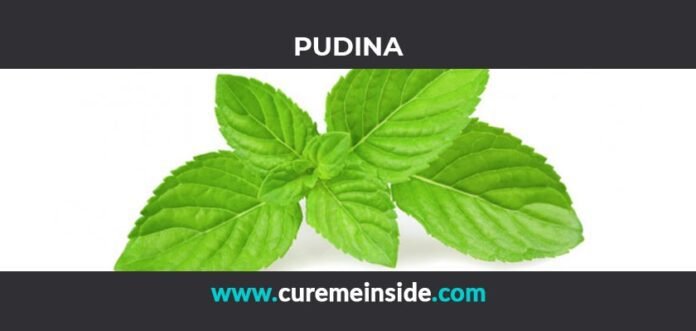01234
Pudina (Mentha viridis)
Brown mint, garden mint, and lady’s mint are all names for pudina.(HR/1)
It has a distinctive aromatic odour and strong flavour and is high in polyphenols. Pudina’s carminative (gas-relieving) and antispasmodic properties help in digestion and weight management. Bloating and gas can be relieved by chewing Pudina leaves. Indigestion can also be relieved by taking pudina tablets or drops. Its antioxidant properties may also aid in boosting brain functions by reducing cell damage. Because of their cooling properties, the essential oils in it may be good for toothaches.Due to its antioxidant characteristics, drinking Pudina tea on a regular basis aids weight loss by increasing metabolism. Due to its antiinflammatory properties, pudina leaf powder used to the skin with rose water helps to get rid of acne, scars, and spots. Because of its antibacterial properties, applying fresh Pudina leaf paste to the skin can aid with boils and skin diseases. To avoid skin irritation, Pudina oil should be mixed with a carrier oil such as coconut oil and used in a diluted form.
Pudina is also known as :- Mentha viridis, Pudinaa, Spear-Mint, Garden Mint, Phudino, Pudeenaa, Parari pudina, Rocani, Podinakah, Putiha
Pudina is obtained from :- Plant
Uses and benefits of Pudina:-
As per several scientific studies, uses and benefits of Pudina (Mentha viridis) are mentioned as per below(HR/2)
Video Tutorial
Precautions to be taken while using Pudina:-
As per several scientific studies, below precautions should to be taken while taking Pudina (Mentha viridis)(HR/3)
- Pudina should be avoided if you have gastroesophageal reflux disease (GERD) as it can worsen the symptoms due to its Ushna (hot) potency.
- Use the paste of Pudina leaves with rose water if your skin is hypersensitive, due to its Ushna (hot) potency.
- Use Pudina oil by diluting with coconut oil before applying on the skin because of its Tikshna (sharp) nature.
Special precautions to be taken while taking Pudina:-
As per several scientific studies, below special precautions should to be taken while taking Pudina (Mentha viridis)(HR/4)
- Patients with kidney disease : If you have kidney illness, stay away from Pudina.
- Patients with liver disease : If you have liver problems, stay away from Pudina.
- Pregnancy : Before using Pudina while pregnant, talk to your doctor.
How to take Pudina:-
As per several scientific studies, Pudina (Mentha viridis) can be taken into the methods mentioned as per below(HR/5)
- Pudina Tablets : Take one to two Pudina tablets. Swallow it with water one to two times a day after dishes.
- Pudina Capsule : Take one to two Pudina capsule. Swallow it with water one to two times a day after dishes, or, Take one to two Pudina capsule. Swallow it with water one to two times a day after dishes.
- Pudina drops : Take fifteen to twenty Pudina drops. Add one glass of water to it and also take ideally after dishes to assist far better digestion.
- Pudina oil : Take one to two drops Pudina oil. Add one glass of water to it as well as take preferably after meals to assist better digestion.
- Pudina Kwath : Take four to eight teaspoons of Pudina Kwath. Add an equal amount of water to itDrink it ideally in the morning and night
- Pudina Tea : Boil one cup of water in a pan. Pour the warm water into a cup having tea leaves. Leave to high for ten minutes. Crush fresh Pudina leaves as well as add them to the cup. Add three to four drops of lemon.
- Pudina Fresh Leaves : Take 5 to eight leaves of Pudina. Crush them to develop a paste. Apply on the ulcers and also boils. Let it sit for five to seven minutes. Wash extensively with faucet waterUse this remedy two to three times a week to eliminate abscess and also boils.
- Pudina Kwath : Take two to three teaspoons of Pudina KwathUse it to wash the wounds for efficient injury healing.
- Pudina Powder : Take half to one teaspoon of Pudina powder. Add Rose water to it. Apply evenly on the affected area. Let it rest 5 to eight minutes. Wash completely with tap water. Use this solution two to three times a week to eliminate Black places and marks on the skin.
- Pudina oil (Peppermint oil) : Take Pudina oil two to five drops. Mix with coconut oil. Apply to the influenced area. Do it once daily till your signs and symptoms diminish.
How much Pudina should be taken:-
As per several scientific studies, Pudina (Mentha viridis) should be taken into the amounts mentioned as per below(HR/6)
- Pudina Tablet : One to two tablets twice a day.
- Pudina Drop : 15to 20 drops once or twice a day.
- Pudina Capsule : One to two capsules twice a day.
- Pudina Churna : One fourth to half teaspoon twice day.
- Pudina Oil : One to two drops once or twice a day, or, Two to five drops or as per your requirement.
- Pudina Powder : Half to one teaspoon or as per your requirement.
Side effects of Pudina:-
As per several scientific studies, below side effects need to be taken into consideration while taking Pudina (Mentha viridis)(HR/7)
- There is not enough scientific data available about side effects of this herb yet.
Questions asked frequently Related to the Pudina:-
Question. How do I preserve fresh Pudina leaves?
Answer. Method 1: Take some fresh Pudina leaves and thoroughly wash them. 2. Spread them out on the filter paper and cook for 15-20 seconds in the microwave. 3. Pulverize the leaves into a powder. 4. Keep this powder in an airtight container or a clean zip lock bag. Method 2: Wash the Pudina leaves thoroughly. 2. Lay them out on the filter paper to dry. 3. Store it in a zip-lock bag in the refrigerator. 4. This procedure will keep the greens fresh for 2-3 days.
Question. Do Pudina leaves lose their properties on drying?
Answer. There are several methods for drying Pudina or any other plant while maintaining its qualities, and the method chosen is entirely dependent on the method utilised. The qualities of Pudina will deteriorate if it is dried directly in the sun.
Question. Is there a difference between peppermint and spearmint?
Answer. Peppermint is a cross between spearmint and watermint, and hence they are very similar. Peppermint has a stronger menthol fragrance, is slightly darker in colour, and has fewer hairy leaves than spearmint.
Question. Is Pudina toxic to humans?
Answer. Pudina is non-toxic and contains a number of therapeutic properties. However, there is a Pudina variant known as Purple Mint that is harmful to cattle and horses but not to humans.
Question. What are the benefits of eating Pudina (mint) leaves?
Answer. Eating Pudina (mint) leaves is thought to be helpful to one’s health since they contain antioxidants. It aids in the battle against free radical-caused cell damage. Pudina leaves also serve as a carminative, reducing bloating and gas and thereby aiding in the management of gastrointestinal diseases, nausea, and vomiting.
Pudina leaves have a lot of health benefits. Due to its Ushna (hot), Deepan (appetiser), and Pachan (digestion) qualities, they aid digestion and increase appetite. Due to its Grahi (absorbent), Kapha-Vata balancing, and Balya (strength provider) qualities, they can also aid with disorders including diarrhoea, vomiting, and gastrointestinal pain. This is beneficial to a person’s general health.
Question. Does Pudina help improve irritable bowel syndrome?
Answer. Yes, Pudina may assist with bloating, abdominal pain, nausea, and vomiting, which are all symptoms of irritable bowel syndrome (IBS). This is due to its anti-inflammatory properties, which aid in the reduction of chronic gastrointestinal irritation. Furthermore, Pudina’s laxative properties aid in the management of constipation by increasing bowel movement.
Irritable bowel syndrome is caused by a dosha imbalance, which results in weak or poor digestion and the production of Ama. Due to its Deepan (appetiser) and Pachan (digestion) qualities, pudina aids digestion and reduces Ama. Due to its Grahi (absorbent) quality, it also aids in the control of excessive stools and the reduction of mucus passage.
Question. Does Pudina help relieve indigestion?
Answer. Yes, due to the presence of specific ingredients such as carvone, Pudina may help reduce indigestion and its related symptoms such as gas. Carnove has a carminative effect, which helps to relieve flatulence.
Indigestion is caused by a Pitta dosha imbalance. Due to its Ushan (hot), Deepan (appetiser), and Pachan (digestion) qualities, pudina aids in normal digestion and provides relief from indigestion. Tips: 1. Gather as many fresh Pudina leaves as you need. 2. Boil these leaves for 10-15 minutes in water. 3. Filter it and drink it hot after a meal to help with digestion.
Question. Can Pudina help improve brain function and prevent memory loss?
Answer. Yes, due to the inclusion of specific ingredients such as rosmarinic acid, Pudina may assist to boost brain function and prevent memory loss. These components include antioxidant and anticholinesterase capabilities, which aid to prevent free radical damage to brain cells.
An increase in Vata dosha might cause problems with memory and brain function. Pudina helps to strengthen nerves, resulting in increased brain function and memory. Due to its Vata balancing and Balya (strength providing) characteristics, this is the case.
Question. Is Pudina helpful in reducing pain due to breastfeeding?
Answer. Yes, Pudina may be beneficial in relieving pain caused by nursing. Pudina’s anti-inflammatory and numbing properties aid in the reduction of pain, itching, and discomfort associated with nursing.
Question. Does Pudina help improve sterility in men and women?
Answer. There is insufficient scientific data to support Pudina’s involvement in improving sterility in men and women.
Question. What are the benefits of drinking Pudina (mint) tea?
Answer. Drinking Pudina (mint) tea is extremely beneficial to one’s health. It is high in antioxidants, which aid in the battle against cell damage produced by free radicals, hence assisting in the management and prevention of certain diseases. Because of its carminative properties, it can also be used to treat digestive problems.
Question. How can I use Pudina for weight loss?
Answer. Pudina has several chemicals that may aid in weight loss. It can be put to the following use: 1. Fill a jar halfway with water. 2. Fill the jar with 5-6 mint leaves. 3. Keep it refrigerated overnight. 4. Drink this water over the next day at various intervals.
Weight gain is a condition that happens as a result of a weak or inadequate digestive system. As a result, toxins are formed and accumulated in the form of extra fat or Ama. Pudina’s Deepan (appetiser) and Pachan (digestion) qualities may aid in the management of this ailment. It aids in the normal digestion of meals and the maintenance of your body’s metabolic rate, hence assisting in weight loss. Pudina can be included in your everyday diet in the form of cooked vegetables, chutneys, or Pudina water.
Question. What are the benefits of Pudina for skin?
Answer. Pudina is thought to help with acne, dermatitis, blisters, itching, and scabs, among other skin issues. Pudina contains volatile oils with antibacterial and antioxidant qualities that prevent bacteria from growing and causing skin problems.
Question. Is Pudina good for hair?
Answer. Yes, Pudina is helpful for hair because when applied as an oil, it encourages hair growth. Due to its antifungal properties, pudina oil may also aid in the management of dandruff.
An imbalance of Vata and Kapha dosha can cause hair problems such as hair loss, dry hair, dandruff, and itching. Due to its Snigdha (oily) and Vata-Kapha balancing characteristics, pudina oil may help nourish damaged hair and give it a lustrous texture. Tips: For best results, use Pudina oil with coconut oil.
SUMMARY
It has a distinctive aromatic odour and strong flavour and is high in polyphenols. Pudina’s carminative (gas-relieving) and antispasmodic properties help in digestion and weight management.
56789




